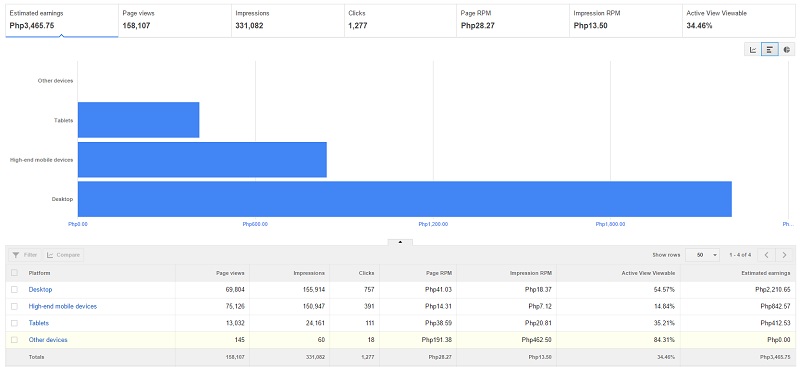Google AdSense is one of the many ad platforms available for publishers/ website owners. It can offer publishers revenue on their websites, games and video content. Advertisers use Google AdExchange and Google AdWords to traffic their ads, while publishers would see the how these ads are delivered to their website in Google AdSense. This post will focus on the revenue I’m getting from Google AdSense via banner ads that appear on one of the newer websites that I manage (not SwirlingOvercoffee.com), what those headers on this report mean, and what the actual CPMs and CPCs are.

This is the data with just the totals:
| Header | Totals |
| Pageviews | 158,107 |
| Impressions | 331,082 |
| Clicks | 1,277 |
| Page RPM | PHP 28.27 |
| Impressions RPM | PHP 13.50 |
| Active View Viewable | 34.46% |
| Estimated Earnings | PHP 3,465.75 |
Pageviews vs Impressions
When a webpage loads, that is considered as 1 pageview. When a banner ad loads, that’s 1 impression. If you have 2 banner ads when the page loads, then you get 2 impressions on 1 pageview, and when a reader scrolls down and loads another banner ad, that’s another impression.
Active View Viewable
This is a percentage of the ads that shows for all of the pageviews. For example, 1 pageview has 3 banner ads. When the page loads, only 1 banner ad shows. This will make your active view veiwable 33.33% (1 out of 3). Say the reader scrolled down and showed the 2nd banner ad, the active view veiwable becomes 66.67%. When the 3rd banner ad shows, then your active view veiwable becomes 100%.
Page RPM vs. Impressions RPM
RPM is Revenue Per Mille or Revenue per thousand impressions. This is not to be confused with CPM or Cost per thousand impressions, more on that later. Page RPM is what you earn per page and Impressions RPM is what you earn per viewed banner ad.
RPM (Revenue per Mille) vs. CPM (Cost per Mille)
The revenue share between Google and their publishers is: 68% to the publisher and 32% to Google. CPM is the amount paid for by the advertiser in Adwords, while RPM is the 68% that you receive. To calculate the CPM we do the Base-Percentage-Rate formula, where we are looking for the base.
Base = Percentage/Rate
B = PHP 13.50/.68
B = PHP 19.85
For this exercise, we know that advertisers paid PHP 19.85 per CPM for the ads: I am getting PHP 13.50 and Google gets PHP 6.35 per CPM.
CPC (Cost per Click)
Some advertisers traffick their ads in AdWords using the CPC model. This means the publisher/ website owner only gets revenue when someone clicks on the ad. Your Google AdSense reports doesn’t list down which ads were served on CPM or CPC. To get the CPC let’s use the estimated earning and the clicks.
CPC = Estimated Earnings / Clicks
CPC = PHP 3,465.75/ 1,277
CPC = PHP 2.71
If we include Google’s 32% just to get a benchmark on the actual CPC:
Base = Percentage/Rate
B = PHP 2.71/.68
B = PHP 4.00
*I updated the calculations since I noticed I made a mistake on the estimated earnings. Instead of PHP866.44, it’s PHP3,465.75 as per the original screenshot.
Conclusion
Knowing your CPM or CPC is a good benchmark if you’re adding another layer for your remnant (non-client direct) inventory in addition to AdSense. It can also be used as a benchmark when negotating CPMs or CPCs with adnetworks.

